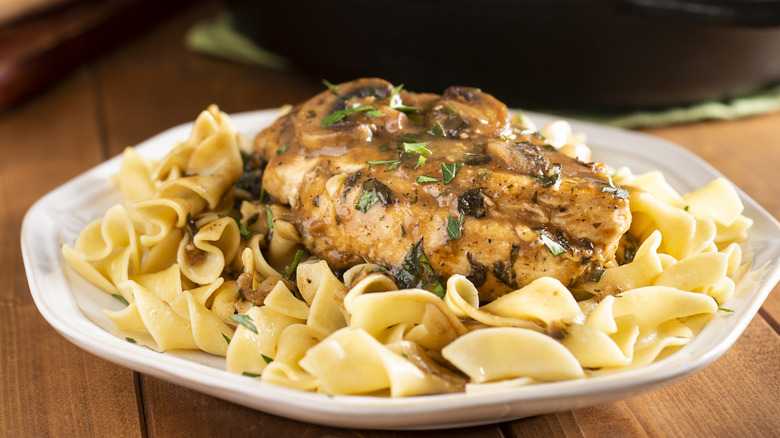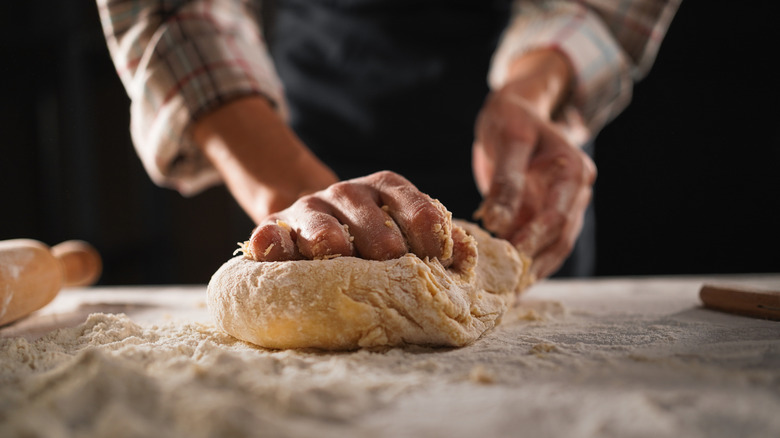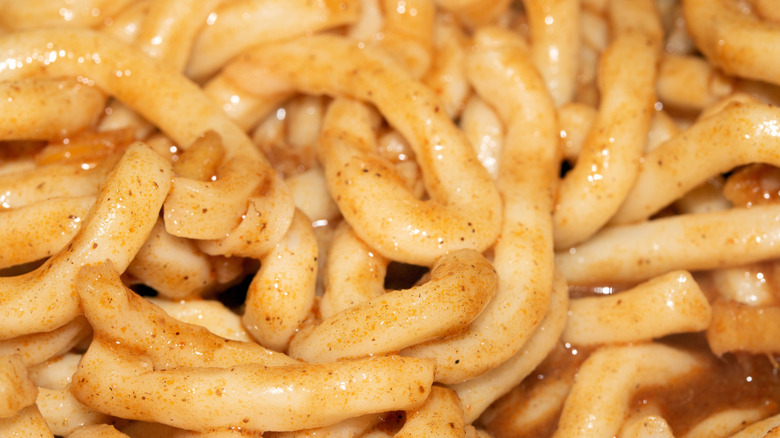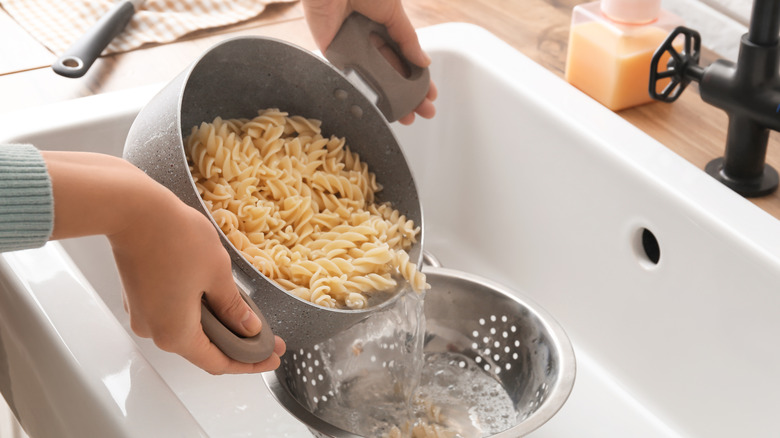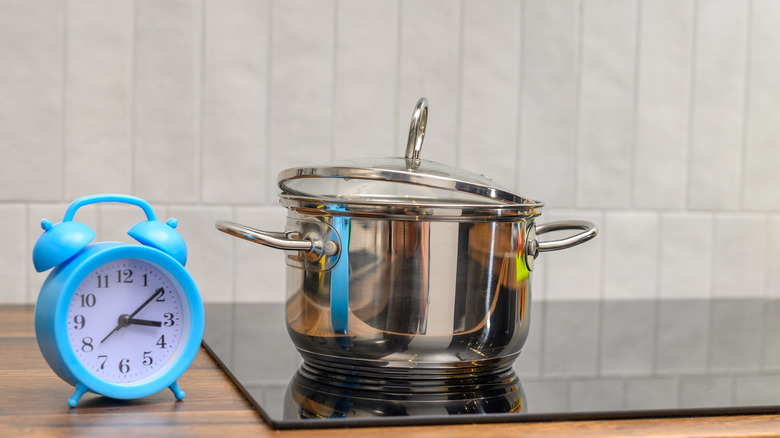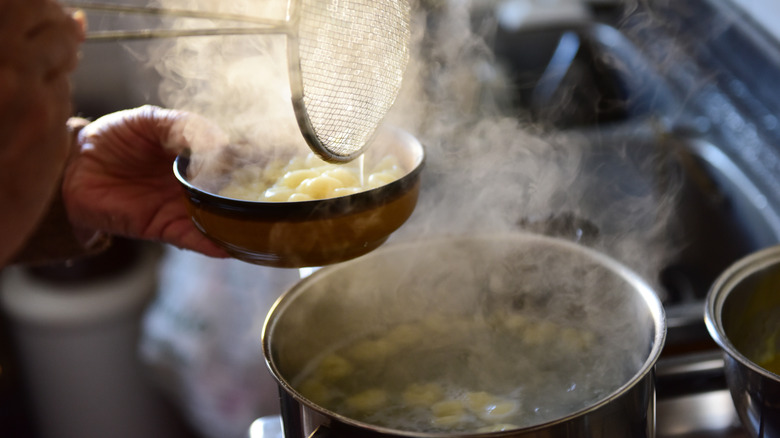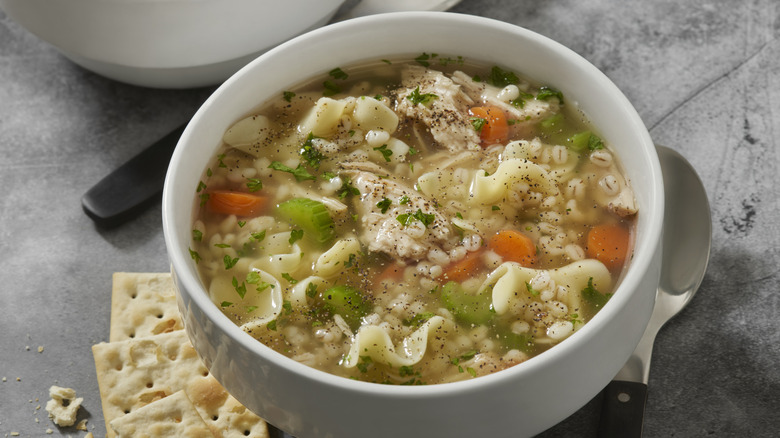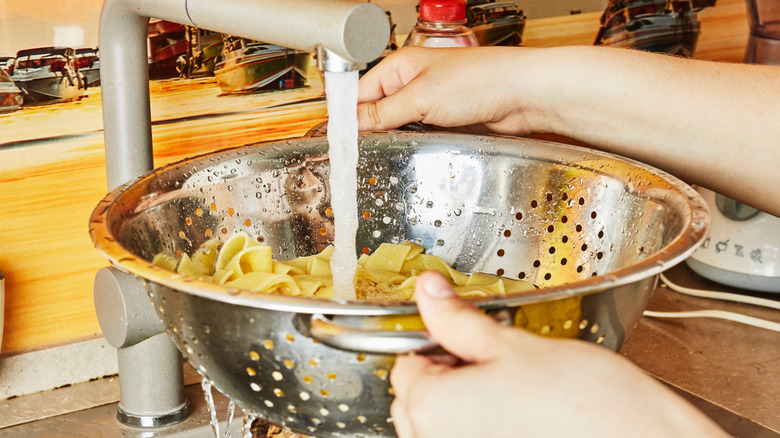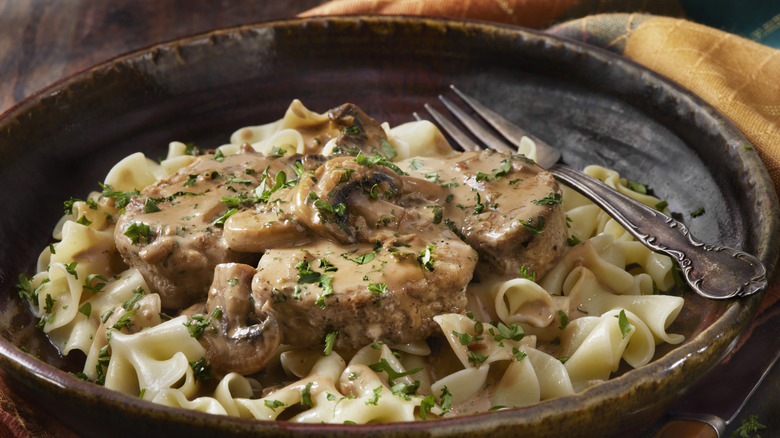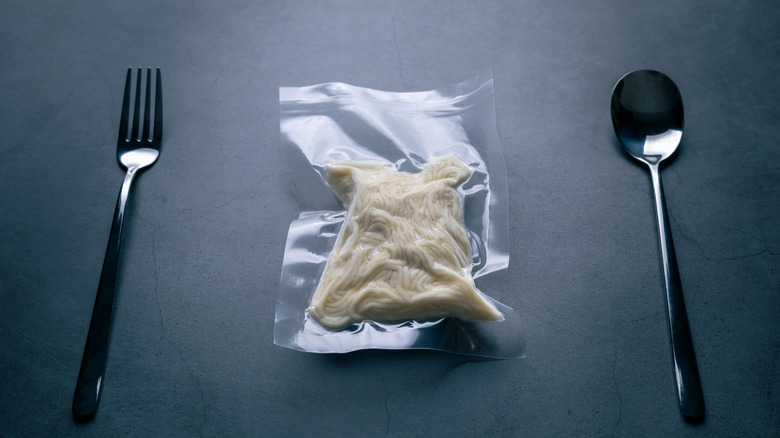10 Mistakes Everyone Makes With Egg Noodles
If you are a big pasta person, you know that there are many varieties to enjoy. Noodles of different shapes, sizes, and ingredients line store aisles, allowing home chefs to customize their choices depending on recipes. Egg noodles are commonly associated with comfort dishes like chicken noodle soup or cream-based casseroles like beef stroganoff. You can also enjoy egg noodles on their own. The wider shape than spaghetti noodles can make it easier to eat, and it is versatile enough to be in salads, soups, and tossed in sauce.
So what makes an egg noodle an egg noodle? Just as the name states, egg noodles are made with eggs, which differs from typical store-bought dried pasta, which is made with durum wheat and water. You also may find egg noodles an appealing option from a nutritional perspective. Egg noodles have fewer calories, a higher cholesterol content, more calcium, and other minerals like magnesium and iron. If you do elect to use egg noodles, there are some differences you should be aware of when selecting, preparing, and storing your noodles. We dove into the mistakes commonly made with egg noodles and are providing some tips to have your egg noodles be the ultimate feel-good meal.
1. Not making your own egg noodles
Making homemade pasta may sound intimidating. But the delicious results are well worth the extra effort. If you have made homemade pasta before, you know that many recipes call for eggs to make the dough richer in flavor and easier to work with. Egg noodles are no exception, with some recipes being as simple as a couple of eggs, flour, salt, and milk. Though other pasta varieties may require a pasta maker for certain cuts like finer spaghetti or linguini, egg noodles can be made by hand. Just combine the ingredients, form your dough, let it rest, then roll it out and cut it with a pizza cutter. Voilà! You have egg noodles ready for boiling (or drying, should you choose to cook later).
A big bonus of making your own egg noodles over store-bought is having control over your ingredients. You can choose higher-quality ingredients, control the texture, and customize your noodles to your dietary needs. Some experimentation may be required, as flour types will respond differently in pasta dough.
2. Not looking at expiration dates on packages
While many would love to make pasta homemade, it just may not be in the cards for a quick weeknight meal. Picking up a bag at the store can certainly be more convenient. If that is the case, you will find options like whole-grain egg noodles and enriched white egg noodles at your retailer. Store-bought egg noodles are shelf-stable to a certain point, though the sooner they are used, the better product quality you will experience.
Dried egg noodles should be used within two years from the purchase date and within two months if stored in the pantry after opening. If you buy fresh noodles, the expiration dates are much sooner. Refrigerated noodles must be used within two days of the purchase date. Freezing fresh pasta gets you two months from the date of purchase. Time is of the essence with fresh pasta due to the eggs and moisture content increasing the potential of foodborne illness. Whether your pasta is fresh or dried, you want to be sure to look for signs of spoilage.
3. Using egg noodles that are too thick
Egg noodles are known for their wide, flat texture. They can have a different size or thickness, especially if you made the noodles yourself. In Chinese cooking, there are thin-cut egg noodles used in Hong Kong or Cantonese-style soups, thicker and wider cut wonton noodles, and a thick but narrowly cut egg noodle for stir-fry and chow mein dishes. There is a bit of flexibility on the thickness of egg noodles, depending on what you plan to do with them. For example, some egg noodles may come in lasagna sheets or spaghetti-like strands.
But you should be mindful of how the noodle size, as well as how large of an amount of noodles, affects the cooking time. Thick and wide noodles need extra cooking time, while thinly cut egg noodles may only need as little as two minutes to cook. The same goes for the amount of noodles — smaller bundles will need less time than larger amounts. If you are making your own noodles, using a pasta maker or attachment on a mixer can ensure the dough is rolled thin enough and is consistently the same size. Sauce adherence is also a factor. Generally speaking, the thicker and chunkier your sauce is, the thicker the noodles should be.
4. Your egg noodles stick together
It can be a huge disappointment when you go to take out your cooked egg noodles to find them in one giant chunk stuck together. This can happen during pasta boiling as starch is released, causing stickiness to happen, especially if your pot is too small. The size of the pot is particularly important because you need four to five quarts of water per pound of pasta, as well as room for the pasta to expand when cooking. Smaller pots mean smaller space and more likelihood for your pasta to stick together.
You also want to be sure to stir your pasta while cooking to keep the starch from building up and causing the pasta to stick together. Stirring regularly also ensures a thorough cook. Some chefs also swear sticking is prevented by adding oil or butter to the water, while others say it can negatively impact the sauce adhering to the noodles after cooking. And if you are not planning on eating your egg noodles right away, storing them with a little olive oil or butter can keep them from clumping in the container.
5. Overcooking your egg noodles
You may be thinking it is impossible to get a bad cook on store-bought noodles. We have all accidentally forgotten to set the timer and walked away from the pot. While it is safe to eat overcooked egg noodles, you probably won't want to when you end up with a mushy, unappealing mess. You definitely want to lean on the safe side from overcooking if you plan to use your egg noodles in another dish like a stir-fry or a casserole where they will end up on a heat source again. Noodles that are not overcooked will be able to handle being cooked again and absorb flavors.
So how long is too long to keep those noodles boiling? There is no exact science, but dried egg noodles should typically take seven to 10 minutes to cook on the stovetop. To ensure you don't overcook your noodles, you should start checking for doneness at least one minute early. That timing changes drastically when you are cooking homemade or fresh egg noodles, as those can be done within as little as a few minutes. Other cooking methods like the slow cooker or microwave are options, but they require timing modifications. If you have ended up with overcooked pasta, not all hope is lost. Sautéing your pasta with a little olive oil can bring back a little texture. You can also repurpose your pasta by serving it chilled in a pasta salad or by adding cheese for macaroni and cheese.
6. Undercooking your noodles
You have likely heard of the Italian term "al dente" before. Translated directly from Italian, al dente means "to the tooth." In regard to pasta, al dente means that your noodle has a little resistance when you bite into it. That being said, you also don't want to end up with your pasta being too undercooked. Not only does slightly crunchy pasta not sound palatable to eat, but there are also safety concerns with undercooked pasta. Being that egg noodles are made with eggs, you want to be sure they are cooked to avoid the risk of salmonella poisoning. You also may notice you have more difficulty digesting undercooked pasta than when it's fully cooked. Undercooked noodles can also impact those with gluten allergies.
Another timing issue is the "carry-over cooking" that occurs when you remove food from heat, and it continues to cook. This is a common occurrence in pasta. While this extra cook time can be considered helpful for undercooked noodles, you certainly shouldn't rely on it to bring your noodles up to safe temperatures. The good news is there are ways to fix your undercooked noodles that are as easy as throwing them back into boiling water for a short period of time, adding them to the sauce and letting it simmer or microwaving. If you want to utilize some more kitchen gadgets, an Instant Pot or steamer are other reheating options.
7. Adding noodles to soups too early
A good soup can be a complete meal with the addition of protein and some carbs like noodles. Egg noodles are a popular choice for chicken noodle soup lovers, as well as popular in Chinese cuisine. But timing is key when making a heavy soup to ensure those noodles hold up. When you leave your noodles in soup for too long, they can become overly soft, eventually breaking down into your soup and giving it a starchy consistency.
Some recipes even suggest cooking your noodles separately and adding them to your soup at serving time. This keeps the noodles from absorbing the broth and losing texture. If you are making your soup ahead of time to enjoy later, don't add uncooked noodles during your initial cooking. Wait to add the egg noodles until you reheat the soup, letting it simmer steadily for 10 minutes. If you do opt to cook your noodles in the soup broth instead of cooking them separately, you should be aware that your broth will become more cloudy in appearance. You shouldn't notice a difference in taste, though.
8. Rinsing your noodles in hot water
Draining and rinsing your noodles in the colander is a habit that many of us have developed after watching previous generations do it for years. It was assumed that the water shock helps them from sticking together and also stops the cooking process. But rinsing your egg noodles in hot water is actually not recommended in most cases. The hot water removes that starch on the pasta surface, which is what helps sauce stick to your noodles. You want those egg noodles covered in their starches, especially if your sauce seems to be a little runny, as pasta starch can act as a thickener.
However, there are some exceptions to the no-rinsing rule. If you plan to serve your egg noodles chilled, like in a pasta salad, rinsing them with cold water can ensure you don't end up with a giant noodle clump. The cooler water also lowers the temperature of the pasta, making it easier to chill your salad. If you plan on serving your dish hot, though, go right from the colander to the plate and skip the water rinse.
9. Substituting egg noodles in other dishes
You may be thinking all pasta is created equal since it contains similar ingredients. While you do have some flexibility substituting out noodles in some dishes, not all substitutions will be successful. Texture is one of the key reasons to consider sticking with noodle recommendations. Egg noodles are a little more delicate than other noodles like a heartier pappardelle. They are commonly used in soups, stir-fries, and various cuisines.
You may be able to use wider-shaped egg noodles in some Italian dishes, while thinner egg noodle varieties may have textural differences as well as differences in size. Shorter egg noodles can be commonly found in dishes like stroganoff, and visually, they wouldn't look the same. You also may notice a difference in taste if other pastas don't have eggs. Egg noodles can have a richer egg taste compared to durum wheat varieties in the store that don't contain eggs.
10. Storing egg noodles improperly
If you have gone through the trouble of making fresh pasta, it isn't surprising that you want to savor it as long as possible. However, the freezing process can hamper the egg noodles' texture, as the expansion occurs from moisture. The quality of the egg noodles suffers, as well as the taste. If you know you have made too much dough, wrap leftovers that haven't been cut in plastic wrap and freeze them in an airtight container or freezer bag for up to one month. However, if you have already gone through the trouble of cutting your egg noodles, you can store them in the refrigerator for one day.
But if you know you won't be cooking them within that timeframe, you can dry your egg noodles at room temperature to then store and reuse them another time. You just want to be mindful of how long your egg noodles sit out — more than two hours at room temperature can increase the risk of salmonella. Once those egg noodles are dried, they can be placed in an airtight container and put in the freezer for up to six months. It should be noted that the dried egg noodles still need to be cooked to kill the bacteria. Dried store-bought pasta can be kept in a cool, dry place(like your pantry) for years. Just be sure the package is sealed or closed well to avoid spoilage and bugs.
